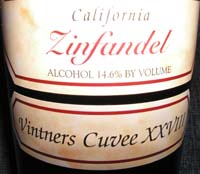Cuvée
Cuvée[edit | edit source]
Cuvée is a term used in winemaking to denote a specific blend or batch of wine. The term originates from the French word "cuve," meaning "vat" or "tank," and it is often used to indicate a wine of superior quality or a special blend. Cuvée can refer to both still wine and sparkling wine, and its usage varies across different wine-producing regions.
Usage in Winemaking[edit | edit source]
In the context of winemaking, cuvée can have several meanings:
- Blending: Cuvée often refers to a blend of wines from different grape varieties, vineyards, or vintages. Winemakers create cuvées to achieve a desired flavor profile, balance, or complexity that might not be possible with a single varietal wine.
- Quality Designation: In some regions, cuvée is used to denote a wine of higher quality. For example, in Champagne, a "cuvée de prestige" is a top-tier sparkling wine made from the best grapes and often aged longer than standard offerings.
- Batch Identification: Cuvée can also refer to a specific batch of wine from a single fermentation tank or vat. This usage is common in regions where wines are produced in large quantities and need to be identified by their production batch.
Cuvée in Sparkling Wine[edit | edit source]
In the production of sparkling wine, particularly in the Champagne region of France, the term cuvée has a specific significance. The initial blend of base wines, which will undergo secondary fermentation to become sparkling wine, is called the cuvée. This blend is crucial as it determines the final characteristics of the sparkling wine, including its flavor, aroma, and effervescence.
Cuvée in Still Wine[edit | edit source]
For still wines, cuvée can indicate a special blend or a wine made from select grapes. Many winemakers use the term to market their premium offerings, suggesting a wine that has been crafted with particular care and attention to detail.
Regional Variations[edit | edit source]
The use of the term cuvée varies widely across different wine-producing regions:
- France: In France, cuvée is commonly used in regions like Bordeaux, Burgundy, and Rhone Valley to denote special blends or high-quality wines.
- Italy: Italian winemakers may use the term "cuvée" to describe a blend, although terms like "Riserva" or "Superiore" are more commonly used to indicate quality.
- United States: In the U.S., cuvée is often used by wineries to label their premium blends, particularly in regions like Napa Valley and Sonoma County.
Related Pages[edit | edit source]
Search WikiMD
Ad.Tired of being Overweight? Try W8MD's NYC physician weight loss.
Semaglutide (Ozempic / Wegovy and Tirzepatide (Mounjaro / Zepbound) available. Call 718 946 5500.
Advertise on WikiMD
|
WikiMD's Wellness Encyclopedia |
| Let Food Be Thy Medicine Medicine Thy Food - Hippocrates |
Translate this page: - East Asian
中文,
日本,
한국어,
South Asian
हिन्दी,
தமிழ்,
తెలుగు,
Urdu,
ಕನ್ನಡ,
Southeast Asian
Indonesian,
Vietnamese,
Thai,
မြန်မာဘာသာ,
বাংলা
European
español,
Deutsch,
français,
Greek,
português do Brasil,
polski,
română,
русский,
Nederlands,
norsk,
svenska,
suomi,
Italian
Middle Eastern & African
عربى,
Turkish,
Persian,
Hebrew,
Afrikaans,
isiZulu,
Kiswahili,
Other
Bulgarian,
Hungarian,
Czech,
Swedish,
മലയാളം,
मराठी,
ਪੰਜਾਬੀ,
ગુજરાતી,
Portuguese,
Ukrainian
Medical Disclaimer: WikiMD is not a substitute for professional medical advice. The information on WikiMD is provided as an information resource only, may be incorrect, outdated or misleading, and is not to be used or relied on for any diagnostic or treatment purposes. Please consult your health care provider before making any healthcare decisions or for guidance about a specific medical condition. WikiMD expressly disclaims responsibility, and shall have no liability, for any damages, loss, injury, or liability whatsoever suffered as a result of your reliance on the information contained in this site. By visiting this site you agree to the foregoing terms and conditions, which may from time to time be changed or supplemented by WikiMD. If you do not agree to the foregoing terms and conditions, you should not enter or use this site. See full disclaimer.
Credits:Most images are courtesy of Wikimedia commons, and templates, categories Wikipedia, licensed under CC BY SA or similar.
Contributors: Prab R. Tumpati, MD

